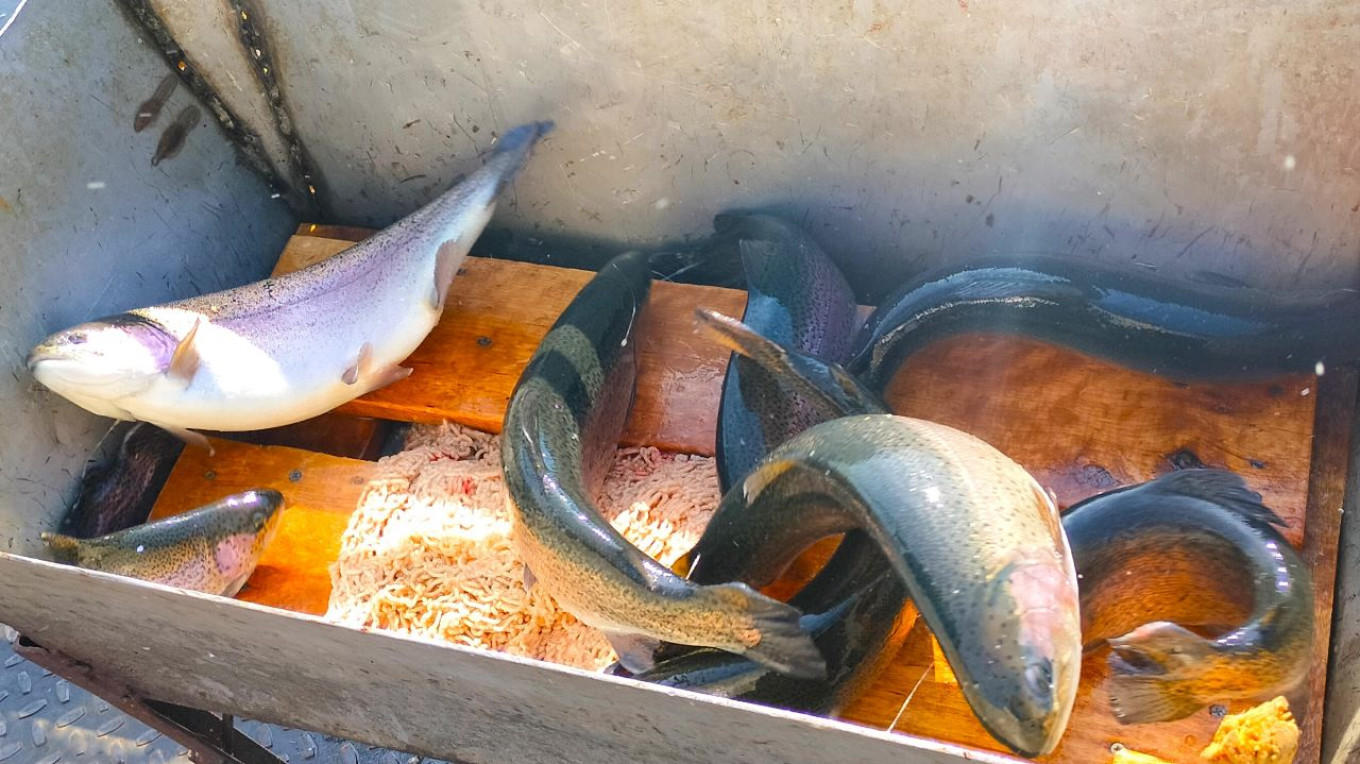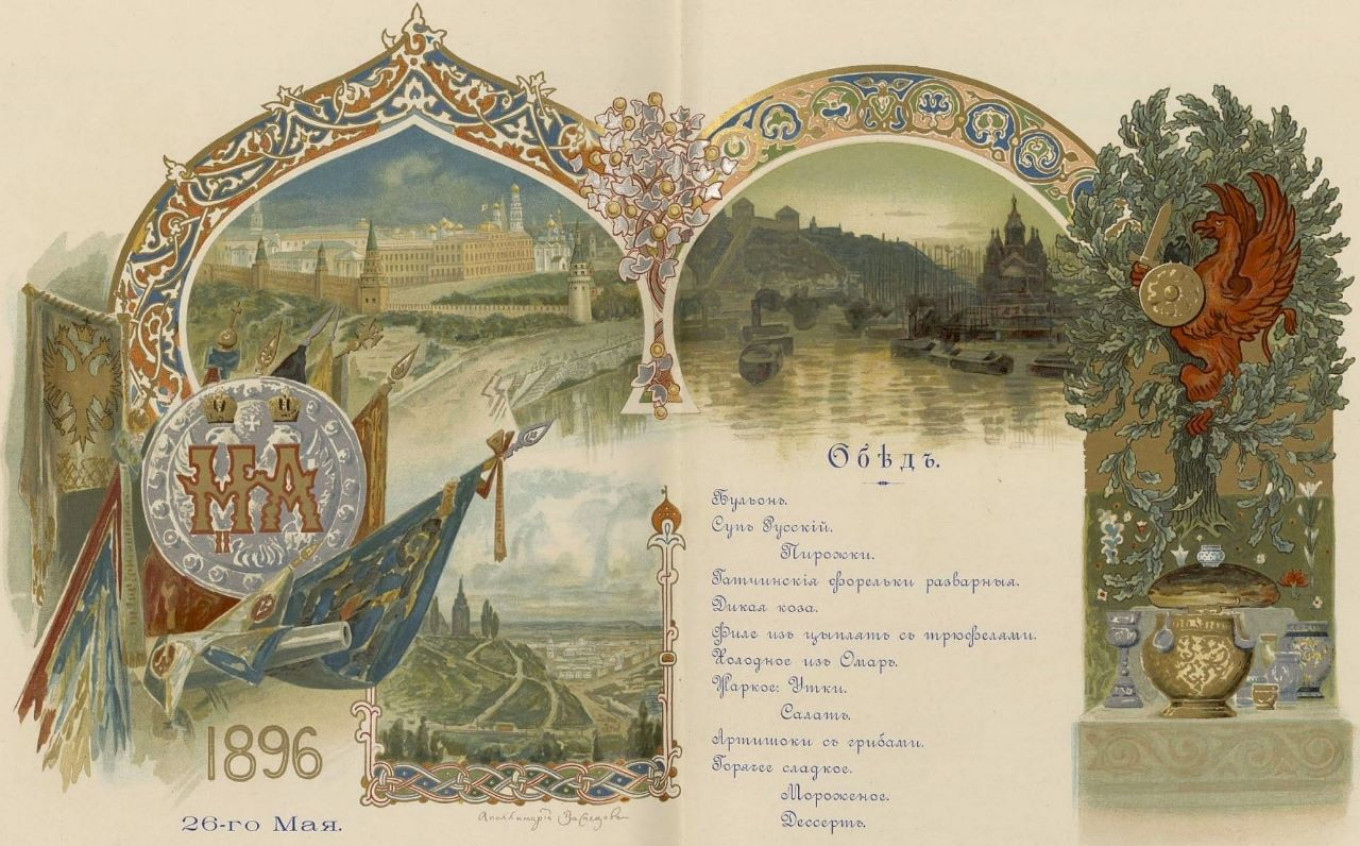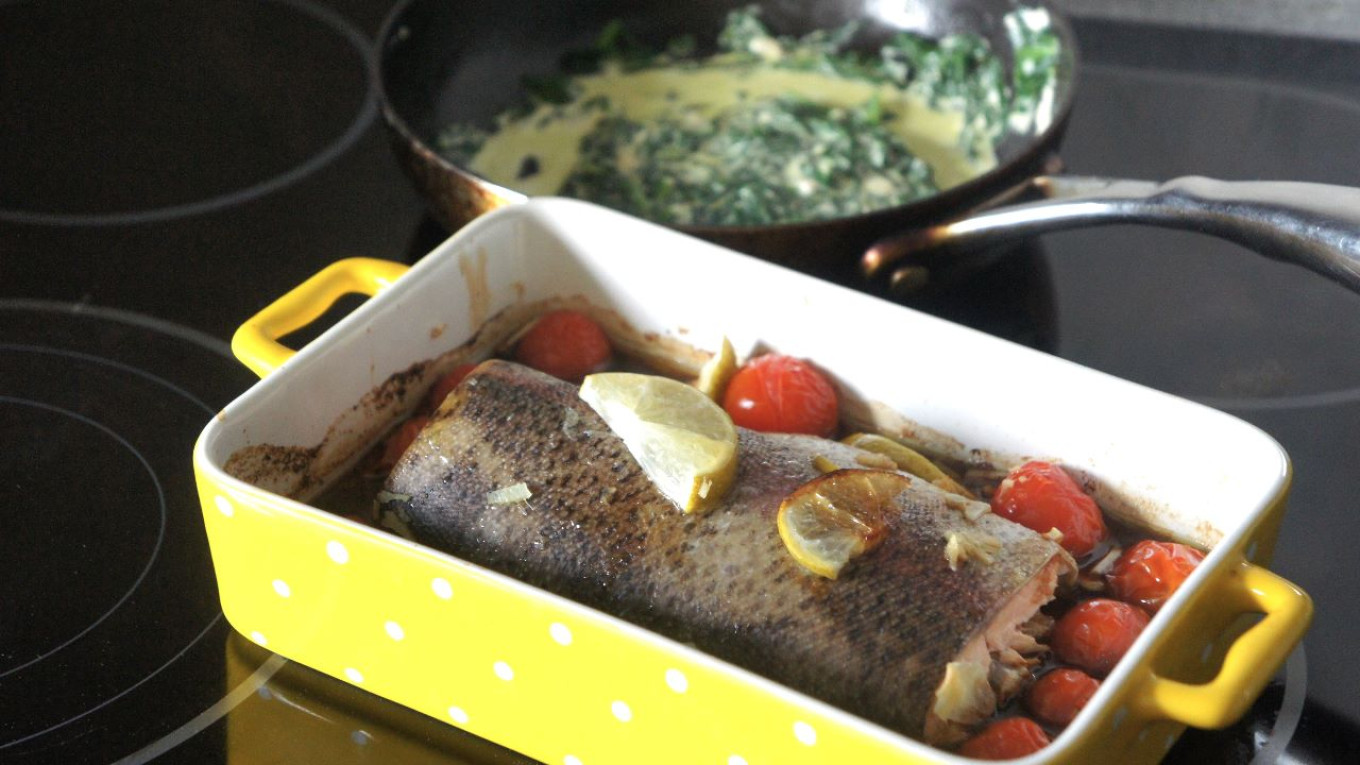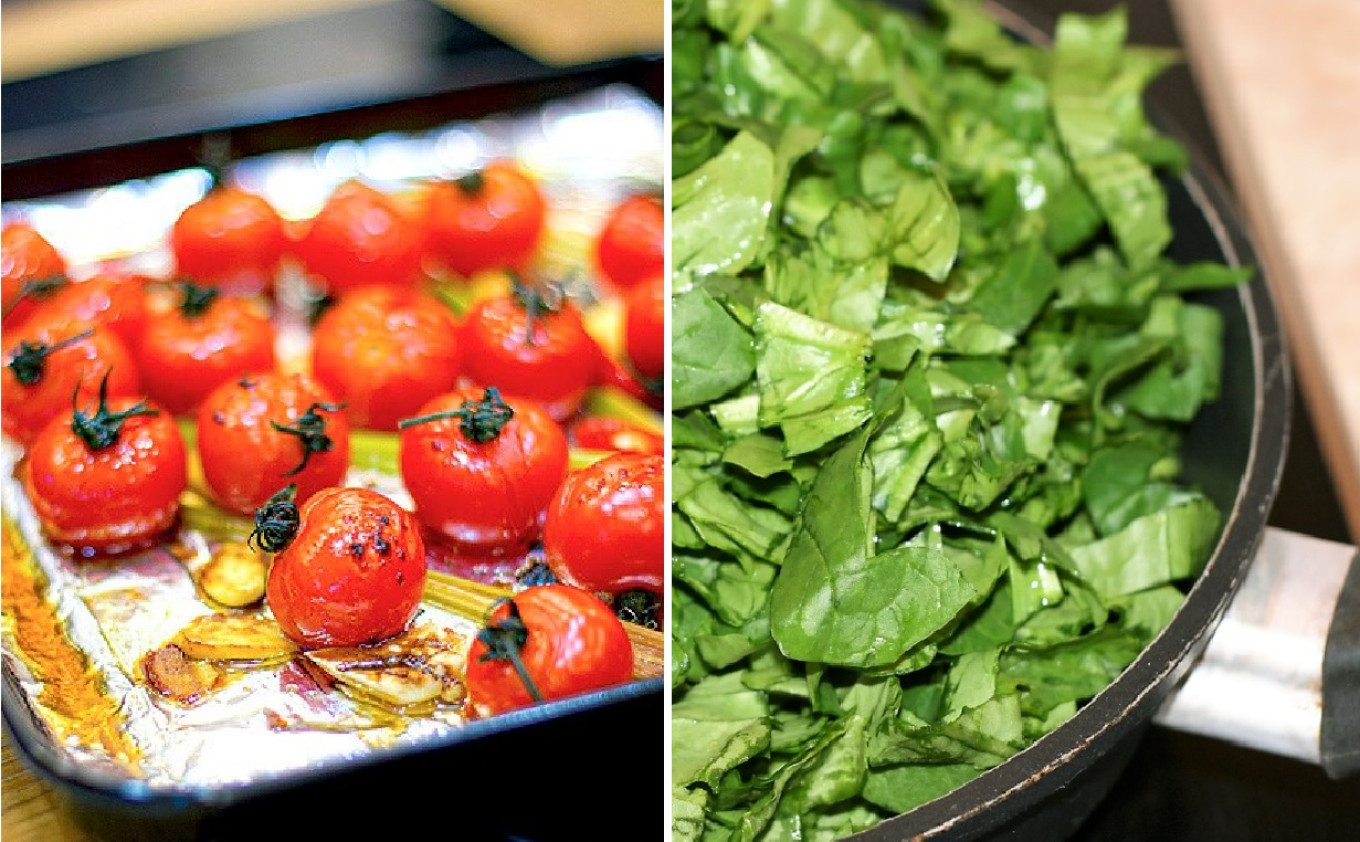Trout is a delicate and yet contrary fish. The slightest slip in the kitchen will ruin the it. The old rule of cooking fish is still true: the simpler, the better. That is, keep the fish and haute cuisine separate. But in that separation is where real culinary artistry might be found.
A couple of years ago the famous St. Petersburg restaurateur Leonid Garbar and his colleagues decided to collect historical recipes and recreate old St. Petersburg cuisine. “When you live in a multinational city,” he says, “where there are many different restaurants, you are drawn to food diversity: you want to have a steak and try pasta, too. But all the same, people have, as they say, Russian blood. There was a good line in one of the guidebooks on Petersburg in the late 19th century: a city dweller would go to Palkin’s — one of the city’s most famous restaurants — order a fat sterlet and cabbage soup, and feel like a Russian.”
The city residents loved the idea and began to send in old recipes. Before they knew it, a stream of these culinary recollections began to flow in. True, most of the letters didn’t offer “specifically St. Petersburg” dishes. Many of them had nothing to do with the city at all. But then a gem of a recipe came in the post, which Leonid Garbar immediately shared with us.
For more than one hundred and fifty years memoirs were kept in the family of Alexander Belokhvostikov. One of the recipes was called “Small Gatchina Trout”:
The freshest trout (350-400 gr) is carefully gutted through the hole at the gills without slitting the belly and without removing scales. Three hours before serving, tie each fish into a ring with a thread, dip its back for a few minutes in a boiling solution of half vinegar and half water, then place it in a colander. A quarter of an hour before dinner, salt the fish, lower in the colander with the fish into a deep saucepan, pour in a broth specially made of small fish and crayfish with white root vegetables, lavender, onions and spices. Cook it through without letting the broth come to a full boil, then place it on a serving dish. Garnish with lemons and capers, small boiled potatoes with parsley and crushed croutons. For the sauce, use broth with Madeira and heavy cream, or olive oil with horseradish and sherry/pear vinegar.
Even people in Russia who know nothing of fishing have heard of the famous Gatchina trout. At one time its connoisseurs were the fable writer Ivan Krylov, the writer and critic Ivan Panayev, the famous lazybones Oblomov (a character from the novel of the same name by writer Ivan Goncharov), and most of the regular patrons of the best restaurants in 19th century St. Petersburg.

The celebrated Russian ichthyologists Leonid Sabaneyev (1844-1898) wrote of the Gatchina trout: “The trout is light in color, almost completely silver, with a pale brown back and a white, slightly yellowish belly. The flesh of these trout is almost completely white, only the larger ones are light pink.” These trout were, of course, very expensive. Before the Revolution a Gatchina trout (a portion of 350 g) was in such great demand that it cost 1 ruble and 20 kopeks. In those days that would have bought 1.2 kg of sturgeon, 3 liters of sour cream, 4 kg of pork or 40 kg of potatoes!
The trout of the Izhora River is a fish of marine origin, a variety of the Baltic trout. Here’s the appetizing description by Elena Molokhovets, author of classic Russian culinary literature, the culinary encyclopedia “A Gift to Young Housewives”: “The Neva trout, called truite samonée (salmon trout) by the French, is the most delicious of all the varieties of trout. It has a small head, a thick body with flesh that is pink-red in color and very tender. It should be spiked 10 minutes before cooking.”
The members of the Romanov dynasty were devotees of the Gatchina trout for centuries. The trout were served at official receptions, including the last coronation of Emperor Nicholas II and his wife Alexandra, at royal picnics and at their own table.
Below: Boiled Gatchina trout by A.N. Benois. Menu of the dinner in the Faceted Chamber of the Moscow Kremlin in 1896 on the occasion of the coronation of Nicholas II and Alexandra.

It might seem otherwise, but the topic of fish in Russian cuisine is not as simple as you might think. On the one hand, the cuisine is rich in fish dishes: fish pies, fish pastries, and dried, salted fish. But in 19th century one had to go to French cooks for a dish of fish that would be simply and elegantly cooked.
In the capital, small eateries were on a par with the best restaurants: both of them did it badly.
“I had the brilliant idea of ordering the famous Gatchina trout that was on the menus of Dussault and Donon [famous restaurants of St Petersburg in the 19th century] and cost almost more than a ruble in silver,” wrote a correspondent of the Sovremennik magazine in 1857. “Gatchina trout in Gatchina… What could be better? When I asked if they had trout, the waiter said they ‘could get them.’ I ordered the trout to be cooked simply, without any seasoning, and I waited impatiently.
“An hour later the trout was presented to me, but how had it been prepared?! The horror of it! It was covered with a thick sauce of flour and rancid butter with moldy capers and olives, all sprinkled with parsley.
‘You barbarian!’ I shouted at the waiter, my expression one of bitter reproach that was not as bitter as the butter in the trout sauce. ‘Barbarian! Didn’t I tell you to boil the trout without seasoning?’
‘You can’t have it any other way. But if you please, sir, all fine gentlemen eat it this way. This is Hollandaise sauce,’ the gentleman answered, staring at me dumbly.”
The sauce is key to trout. We realized this a long time ago and have always tried to combine originality with a delicate flavor — and we hope we’ve succeeded. As for the fish itself, there is nothing much to describe: we just take trout and bake it without any seasoning or salt. But we serve it with spinach in cream and cherry tomatoes baked with lemongrass and ginger.
Trout With Cherry Tomatoes and Spinach

Ingredients
Trout
- 600-700 g (1.3-1.5 lb) trout (without head and tail)
- 1/2 lemon
- 2 sprigs of thyme
- olive oil
Cherry tomatoes
- 300 g (10.5 oz) on-the-vine cherry tomatoes
- 1 stalk of fresh lemongrass (lemongrass)
- 2 garlic cloves
- 3 to 4 pieces fresh ginger
- 1 hot chili pepper
- 1 tsp soy sauce
- 100 ml (1/2 c minus 1 Tbsp) wine vinegar
- 100 ml (1/2 c minus 1 Tbsp) olive oil
- 2 tsp brown sugar
Creamed spinach
- 400-500g (1 lb) spinach
- 80 ml (1/3 c) 22% fat cream
- 1 Tbsp butter
- salt, freshly ground black pepper
- Optional: 1 Tbsp soft cottage cheese

Instructions
First prepare the cherry tomatoes.
- Preheat oven to 140°C/285°F.
- Wash the tomatoes and use scissors to cut the tomatoes off the vine.
- Trim the top and bottom of the lemongrass stem and remove the outer layer.
- Place the stem on a cutting board and crush it with a rolling pin or kitchen mallet.
- Finely chop the ginger and hot pepper.
- Crush garlic.
- Place lemongrass, ginger, garlic and peppers in the bottom of the pan where the tomatoes will be baked.
- Place tomatoes on top and drizzle with vinegar, olive oil and soy sauce.
- Sprinkle with sugar.
- Bake in the preheated oven for 20 minutes.
- Let cool on the baking tray.
Then prepare the trout
- Preheat the oven to 180°C/350°F.
- Cut the lemon into half rings.
- Place the lemon and thyme sprigs in the belly of the fish.
- Brush the fish with olive oil.
- Place the fish on baking paper and fold the paper in an envelope. Place on a baking tray or in a baking dish.
- Put in the oven and bake the fish for 20-25 minutes, depending on the size of the fish.
While the fish is cooking, prepare the spinach
- Rinse spinach, remove tough stems.
- Melt the butter in a pan and add the spinach.
- Stirring constantly, cook the spinach until all the leaves are soft, 2 to 3 minutes.
- Season with salt and pepper, add cream and stir. You can add soft cream cheese if you wish. Once it comes to a boil, remove from heat.
To serve
- When the fish is almost ready, you can put the tray of baked tomatoes in the oven with the trout for a few minutes to warm it up.
- Serve the trout with tomatoes and spinach.
Leave a Reply